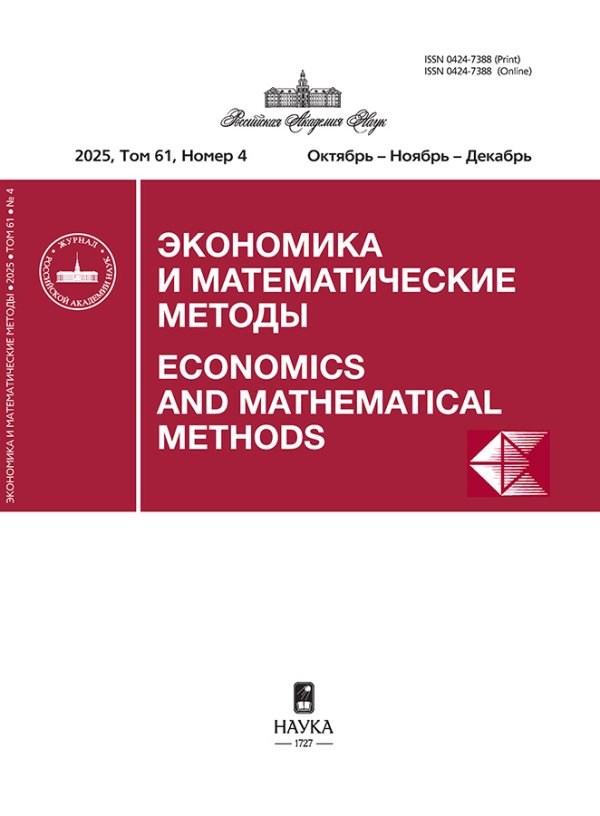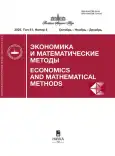Объективные и субъективные факторы в динамике фондовых индексов
- Авторы: Андрукович П.Ф.1
-
Учреждения:
- Центральный экономико-математический институт РАН
- Выпуск: Том 61, № 4 (2025)
- Страницы: 5-17
- Раздел: Мировая экономика
- URL: https://stomuniver.ru/0424-7388/article/view/697026
- DOI: https://doi.org/10.31857/S0424738825040017
- ID: 697026
Цитировать
Полный текст
Аннотация
В данной статье анализируется зависимость динамики фондовых индексов от двух типов факторов — объективных и субъективных, под которыми понимается, с одной стороны, динамика экономического развития, а с другой стороны, действия различных участников фондовых рынков, влияющих как на динамику всего фондового рынка, так и на значения фондовых индексов. В начале статьи рассматривается структура соотношений этих факторов и предполагается, что основной тренд динамики фондового индекса, представленный регрессионной моделью, характеризует результаты действия объективных факторов, а отклонения от него — субъективных. После обзора работ, посвященных построению регрессионных моделей для различных фондовых индексов, дается краткое описание истории создания наиболее известного фондового индекса — индекса Доу–Джонса. На основе динамики этого индекса за 1897–2024 гг. строятся регрессионные модели, описывающие его основной тренд, и анализируются отклонения индекса от этого тренда. Показано, что основными причинами, вызывавшими эти отклонения, являются некорректные по времени и интенсивности изменения списка компаний, по котировкам которых он рассчитывается, сделанные руководителями этого индекса. Эти отклонения интерпретируются как влияние на динамику данного индекса человеческого фактора, субъективного по своей природе. Уровень и значимость этих отклонений оцениваются далее на фоне динамики ВВП США и показывается, что, хотя в отдельные периоды человеческий фактор отклоняет динамику индекса от динамики ВВП США, в целом динамика развития экономики США обладает некоторой «притягательной силой» для динамики индекса Доу–Джонса. В заключение отмечается, что при построении моделей фондовых индексов необходимо учитывать специфические особенности их структуры, включая принципы изменения их списков, роль коэффициентов в формулах вычисления этих индексов и другие их характеристики.
Ключевые слова
Об авторах
П. Ф. Андрукович
Центральный экономико-математический институт РАН
Email: streletspa@yandex.ru
Москва, Россия
Список литературы
- Андрукович П. Ф. (2005). Долгосрочная и среднесрочная динамика индекса Доу–Джонса // Проблемы прогнозирования. № 2. С. 46–62. [Andrukovich P. F. (2005). Long-term and medium-term dynamics of the Dow–Jones index. Studies on Russian Economic Development, 2, 46–62 (in Russian).]
- Андрукович П. Ф. (2016). О двойственной роли корректирующего коэффициента в формуле расчета индекса Доу–Джонса // Экономическая наука современной России. № 3 (74). С. 30–42. [Andrukovich P. F. (2016). On the dual role of the correction factor in the formula for calculating the Dow–Jones index. Economics of Contemporary Russia, 3 (74), 30–42 (in Russian).]
- Андрукович П. Ф. (2017). «Человеческий фактор» в истории изменений списков индекса Доу–Джонса // Экономическая наука современной России. № 3 (78). С. 137–154. [Andrukovich P. F. (2017). The “human factor” in the history of changes in the lists of the Dow–Jones index. Economics of Contemporary Russia, 3 (78), 137–154 (in Russian).]
- Андрукович П. Ф. (2019). Динамика котировок акций при их листинге и делистинге // Журнал Новой экономической ассоциации. № 4 (44). С. 50–76. [Andrukovich P. F. (2019). Dynamics of stock quotations during their listing and delisting. Journal of the New Economic Association, 4 (44), 50–76 (in Russian).]
- Андрукович П. Ф., Лепетиков Д. В. (2024). Несколько историй из жизни индекса Доу–Джонса. М.: ЦЭМИ РАН. 148 с. [Andrukovich P. F., Lepetikov D. V. (2024). Several stories from the life of the Dow Jones index. Moscow: CEMI RAS. 148 p. (in Russian).]
- Бердникова Т. Б. (2013). Рынок ценных бумаг: прошлое, настоящее, будущее. М.: Инфра-М. 397 с. [Berdnikova T. B. (2013). The securities market: Past, present, and future. Moscow: Infra-M. 397 p. (in Russian).]
- Егорова Н. Е., Бахтизин А. Р., Торжевский К. А. (2021). Прогнозирование фондовых рынков с использованием экономико-математических моделей. М.: URSS. 248 с. [Egorova N. E., Bakhtizin A. R., Torzhevsky K. A. (2021). Forecasting stock markets using economic and mathematical models. Moscow: URSS. 248 p. (in Russian).]
- Егорова Н. Е., Торжевский К. А. (2015). Модели и методы анализа фондовых рынков и опыт их применения в условиях России // Экономика и математические методы. Т. 51. № 1. С. 68–79. [Egorova N. E., Torzhevsky K. A. (2015). Models and methods of stock market analysis and the experience of their application in Russia. Economics and Mathematical Methods. 51 (1), 68–79 (in Russian).]
- Кузовкин А. И., Стакун А. В. (2018). Динамика фондового индекса Доу–Джонса в зависимости от ВВП, корпоративной прибыли и цены на нефть в экономике США // Микроэкономика. № 3. С. 68–78. [Kuzovkin A. I., Stakun A. V. (2018). The dynamics of the Dow–Jones stock index as a function of GDP, corporate profits and oil prices in the US economy. Microeconomics, 3, 68–78 (in Russian).]
- Теплов С. Е. (2007). R/S анализ американского фондового, российского фондового и валютного рынков. В сб.: «Финансовый сектор в экономике». М.: МФПА. [Teplov S. E. (2007). R/S analysis of the American stock, Russian stock and foreign exchange markets. In: “The financial sector in the economy”. Moscow: MFIA (in Russian).]
- Цыпин А. П. (2016). Сравнительный статистический анализ динамики индексов Доу–Джонса и ММВБ // Системное управление. № 1 (46). С. 46–55. [Tsypin A. P. (2016). Comparative statistical analysis of the dynamics of the Dow–Jones and MICEX indices. System Management, 1 (46), 46–55 (in Russian).]
- Adebayo F. A., Sivasamy R., Shangodoyin D. K. (2014). Forecasting stock market series with Arima model. Journal of Statistical and Econometric Methods, 3 (3), 65–77.
- Affleck-Graves J.F. (1977). The application of multivariate statistical techniques in the analysis of stock market data. Cape Town: University of Cape Town.
- Arias M., Arratia A., Xuriguera R. (2013). Forecasting with Twitter data. ACM transactions on Intelligent Systems and Technology, December, 1–25. doi: 10.1145/2542182.2542190
- Bahrammirzaee A. (2010). A comparative survey of artificial intelligence applications in finance: Artificial neural networks, expert system and hybrid intelligent systems. Neural Computing and Applications, 19 (8), 1165–1195.
- Bhandari H. N., Rimal B., Pokhrel N. R., Rimal R., Dahal K. R., Khatri R. K.C. (2022). Predicting stock market index using LSTM. Machine Learning with Applications, 9 (15), 2–15.
- Bollen J., Mao H., Zeng X. (2011). Twitter mood predicts the stock market. Journal of Computational Science, 2 (1), 1–8.
- Cao J., Wang J. (2020). Exploration of stock index change prediction model based on the combination of principal component analysis and artificial neural network. Soft Computing, 24 (1), 7851–7860. doi: 10.1007/s00500-019-03918-3
- Duarte F. B., Machado J. T., Duarte G. M. (2010). Dynamics of the Dow–Jones and the NASDAQ stock indexes. Nonlinear Dynamics, September, 1–17. doi: 10.1007/s11071-010-9680-z
- Enke D., Grauer M., Mehdiyev N. (2011). Stock market prediction with multiple regression, fuzzy type-2 clustering and neural networks. Procedia Computer Science, 6 (8), 201–206. Available at: https://www.sciencedirect.com/science/article/pii/S1877050911005035
- Fama E. F. (1965). The behavior of stock-market prices. The Journal of Business, 38 (1), 34–105.
- Franke J., Härdle W.K., Hafner C.M. (2008). Statistics of financial markets: An introduction. 2nd ed. N.Y.: Springer. 498 p. ISBN: 978–3–540–76269–0; doi: 10.1007/978-3-540-76272-0
- Ghiassi M., Skinner J., Zimbra D. (2013). Twitter brand sentiment analysis: A hybrid system using N-gram analysis and dynamic artificial neural network. Expert Systems with Applications, 40 (16), 6266–6282.
- Handbook of Financial Time Series (2009). T. G. Andersen, R. A. Davis, J. P. Kreiss, T. Mikosch (eds.). N.Y.: Springer. 1050 p. doi: 10.1007/978-3-540-71297-8
- Hansen P. R., Huang Z., Shek H. H. (2011). Realized GARCH: A joint model for returns and realized measures of volatility. Journal of Applied Econometrics, 27 (6), 877–906. doi: 10.1002/jae.1234
- Jin R., Wang Sh., Yan F., Zhu J. (2015). The application of ARIMA model in 2014 shanghai composite stock price index. Journal of Applied Mathematics and Statistics, 3 (4), 199–203.
- Seethalakshmi R. (2018). Analysis of stock market predictor variables using linear regression. International Journal of Pure and Applied Mathematics, 119 (15), 369–378.
- Sprenger T. O., Tumasjan A., Sandner P. G., Welpe I. M. (2013). Tweets and trades: The information content of stock microblogs. European Financial Management, 20 (5), 926–957. doi: 10.1111/j.1468-036x.2013.12007.x
- Stockhammar P. (2010). Comovements of the Dow–Jones stock index and US GDP. Research Report, 2, 1, 1–29. Stockholm University, Department of Statistics.
- Suharsono A., Ahmad I. S., Wibisono A., Pramesti W. (2018). Modeling of autoregressive moving average and vector autoregressive for forecasting stock price index in ASEAN countries. International Journal of Mechanical Engineering and Technology, 9, 309–319.
- Taran R. (2022). Stock market analysis using linear regression. Proceedings of the Jepson Undergraduate Conference on International Economics, 4, Article 4, 1–7.
- Wilkens S. (2022). Predicting stock index changes. The Journal of Portfolio Management, 48, 7, 175–194.
- Yan K., Gupta R., Haddad S. (2022). Statistical analysis Dow–Jones stock index — cumulative return gap and finite difference method. J. Risk Financial Management, 15 (89), 1–44. doi: 10.3390/jrfm15020089
Дополнительные файлы











